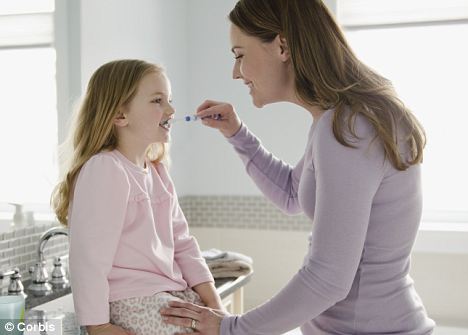[vc_row][vc_column][vc_column_text]
5 Dental Care Tips for Very Young Children
Healthy teeth and gums are absolutely essential – not just for you, but for your entire family. Starting early with your offspring is key. You want to do everything you can to give them a great start to a lifetime of happy smiles.
Get to a dentist early and start health habits.
Most adults need a dental checkup and cleaning two times a year. The same goes for kids, but how soon should that start? Both the AAPD (American Academy of Pediatric Dentists) and the American Academy of Pediatrics say you should take your child to the dentist by his first birthday. In addition to conducting a thorough oral exam, the dentist will obtain a dental history, guide parents on proper brushing habits and cavity prevention, and establish how often a child should visit. The visit also assesses risk, says Lezli Levene Harvell, D.D.S., a board-certified pediatric dentist in Newark, New Jersey (and mom of five girls ages 2 to 14). “If a mom tells me, ‘I had a mouthful of cavities as a kid,’ automatically I’m thinking her child may be at higher risk,” she says. In addition, you’ll establish a dental “home” for your kids where you’ll get the latest information and can feel sure that problems will be spotted when they’re easiest to fix.
The same goes for kids, but how soon should that start? Both the AAPD (American Academy of Pediatric Dentists) and the American Academy of Pediatrics say you should take your child to the dentist by his first birthday. In addition to conducting a thorough oral exam, the dentist will obtain a dental history, guide parents on proper brushing habits and cavity prevention, and establish how often a child should visit. The visit also assesses risk, says Lezli Levene Harvell, D.D.S., a board-certified pediatric dentist in Newark, New Jersey (and mom of five girls ages 2 to 14). “If a mom tells me, ‘I had a mouthful of cavities as a kid,’ automatically I’m thinking her child may be at higher risk,” she says. In addition, you’ll establish a dental “home” for your kids where you’ll get the latest information and can feel sure that problems will be spotted when they’re easiest to fix.
If you’re worried about the cost, know that pediatric dental care is now required to be covered by most health-insurance plans, as well as Medicaid. What’s more, a study in Pediatrics found that kids who saw a dentist before age 1 have overall dental costs in their first five years that are 40% lower than those of kids who don’t.
Use fluoride toothpaste from the very beginning
It’s important to know the American Dental Association now recommends that parents use fluoridated toothpaste as soon as a baby gets his or her first tooth. Don’t think the fluoride in the water is enough all by itself. It’s a place to start, but more is better in this case. Remember only 75% of the water supplies in the U.S. are currently fluoridated. How much toothpaste for baby’s first tooth? A tiny bit is good, at first, as small as a grain of rice that you can build up to the size of a pea as new teeth appear.
Another scary statistic: 25% of U.S. pre-schoolers have at least one cavity. That number grows to more than 50% by kindergarten. Fluoride toothpaste is one of the ways to reverse that trend. It prevents cavities and kills harmful bacterial acids.
Another scary statistic: 25% of U.S. pre-schoolers have at least one cavity. That number grows to more than 50% by kindergarten. Fluoride toothpaste is one of the ways to reverse that trend. It prevents cavities and kills harmful bacterial acids.
Use the right tools and use them right away
There’s almost no ‘too early’ when it comes to brushing – even before that first tooth has arrived. Research indicates that cavity-causing bacteria exists in the folds of the tongue, even before a child has teeth. Wiping your child’s mouth with an infant finger toothbrush is a first step. Once your child gets at least one tooth, move to a soft-bristled kids’ toothbrush and fluoride toothpaste. Now that you’re adding toothpaste, start small (the size of a grain of rice). More teeth, use more toothpaste. You’ll work up to the size of a pea. Up to the age of 6 or so your child will probably need help to brush effectively. Another way to keep your child’s mouth free from unwanted germs is to avoid behaviors that get your saliva into your little one’s mouth. This is one time you shouldn’t share. Don’t share spoons or cups and don’t clean his pacifier with your mouth.
Gently, gently
Aggressive brushing for the very young can do as much harm as good to teeth and gums. So tilt the bristles a bit toward the gums and move in tiny little circles, touching every surface of every tooth. For kids five years old and under, do your best to get to all the surfaces in a process that may not take more than a minute or so.
Flossing even for the young ones, really matters
Many parents believe that flossing isn’t an issue until permanent teeth come in, but in fact, flossing can help with health as soon as the teeth – even new teeth – are touching each other and debris can lodge between them. You’ll want to get all that food – and plaque! – out at any age. Disposable flossers designed especially for kids are perfectly fine, as long as they’re used properly. And yes, you may get ‘bit’ a few times, especially with fussy kids, but it’s worth the effort.[/vc_column_text][/vc_column][/vc_row]
